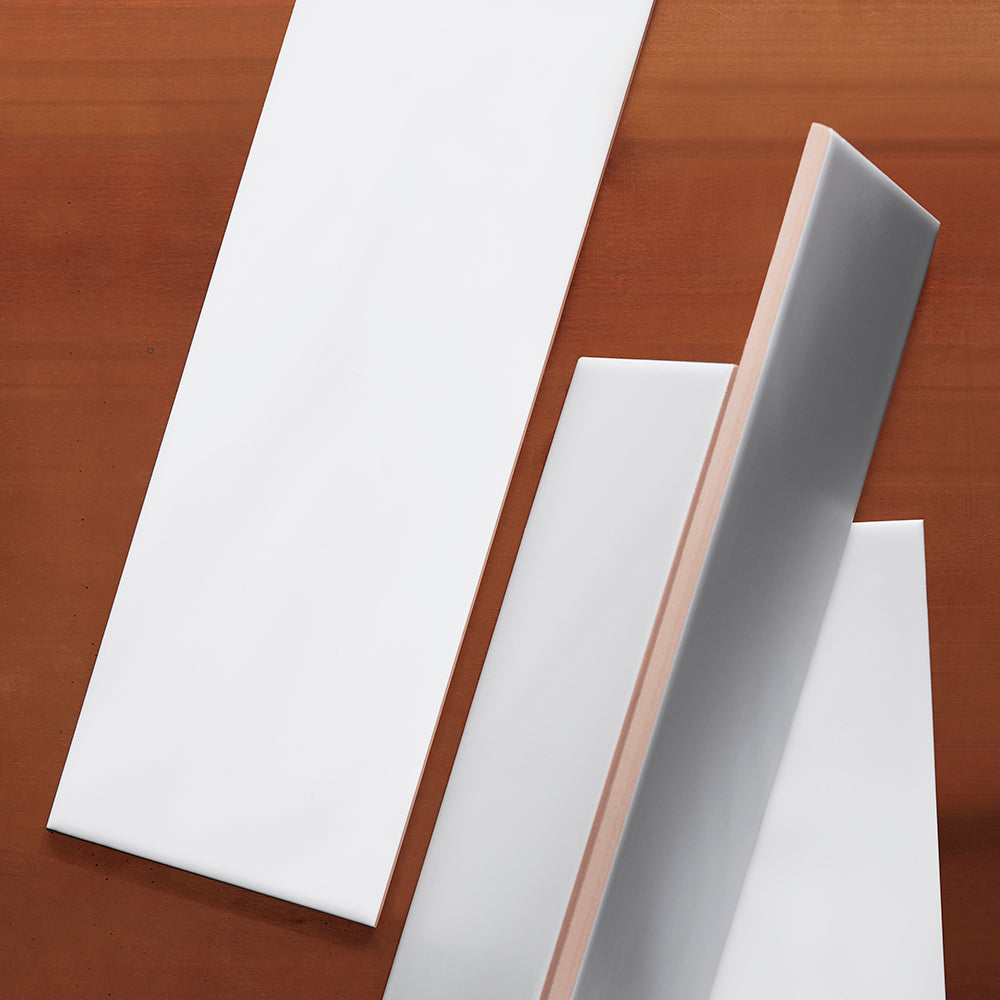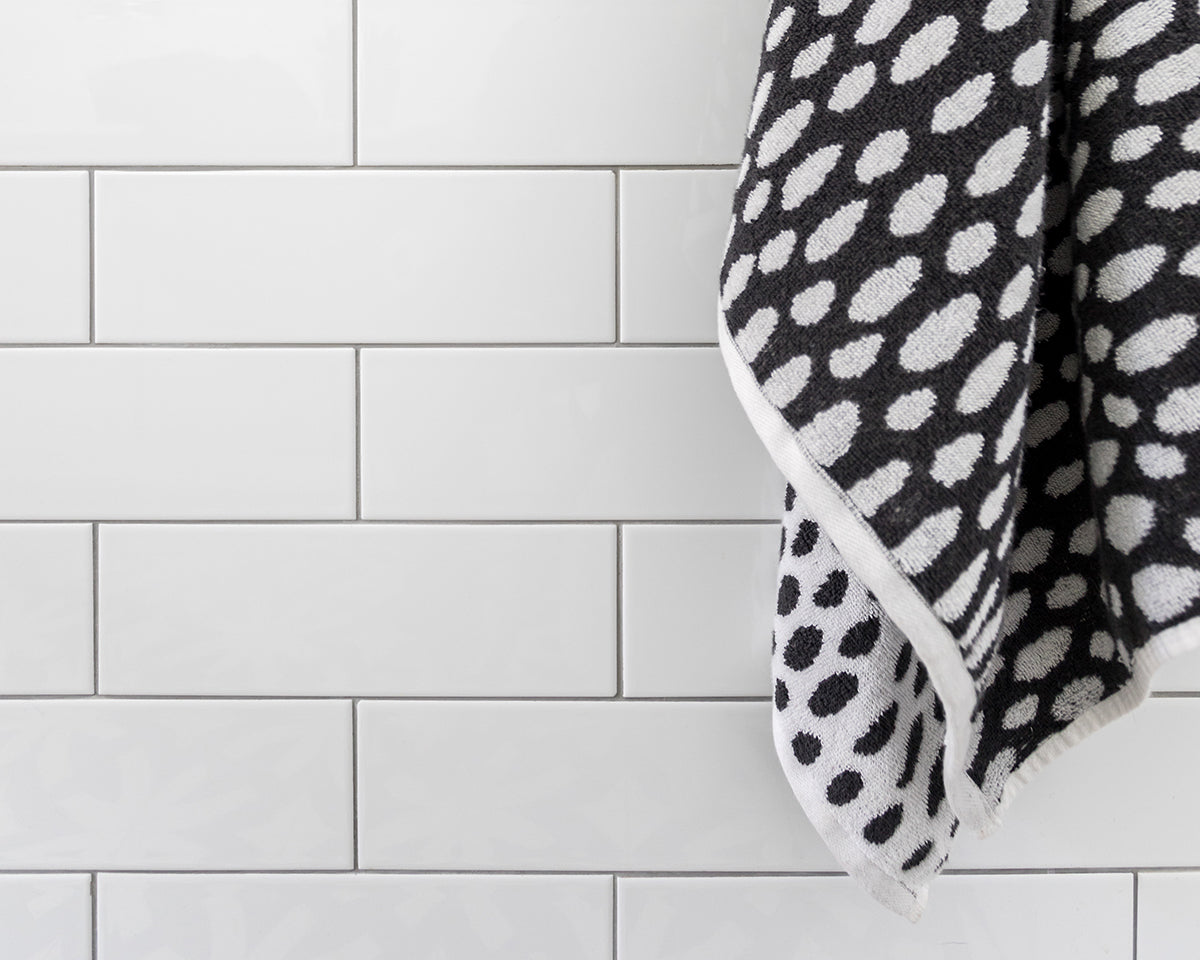understanding ceramic tile thickness & why it matters
by clé tile | published: Apr 11, 2024

ceramic basics 3x6 subway in white gloss
ceramic tile thickness might not be the first thing on your mind when envisioning your dream project, but it’s an important factor to consider. the thickness of the tile you choose can impact everything from the installation process to the look and feel of your finished project.
understandably, this can be a complex topic if you’re not in the industry. so, we’ve put together a guide to help you understand everything you need to know about ceramic tile thickness during the planning process.
how thick is ceramic tile?
the standard thickness of ceramic tile can range from 6 mm to 12 mm (¼ to ½ inch). the tile’s exact thickness depends on a number of factors, including the material, manufacturing process, and intended use. for example, decorative and wall tiles tend to be thinner, while floor tiles tend to be thicker to withstand foot traffic and the weight of furniture.
why ceramic tile thickness matters
ceramic tiles are extremely versatile and can be used for a variety of applications, from bathrooms and kitchens to laundry rooms. in general, thicker ceramic tiles offer greater durability and stronger hardness ratings, but that’s not the only reason ceramic tile thickness matters. let’s take a look.
aesthetics
ceramic tile thickness can play a key role in the overall aesthetics of your space. thicker tiles tend to have a more robust appearance, while thinner tiles appear sleeker and more streamlined. overall though, it really does vary from tile to tile.
the architectural style of your space may also influence your choice of tile size and thickness. for instance, thicker tiles could align with a more traditional or rustic design, while thinner tiles may complement a modern or minimalistic approach. on the other hand, larger tiles can make a small space feel larger, while smaller tiles may have the opposite effect.
the thickness of ceramic tiles can also influence how well they transition with other flooring materials in adjacent rooms. for example, if the tile you want to use in your dining room is thinner than the existing flooring in your adjoining kitchen, your contractor will need to use a thicker underlayment beneath the tile to achieve a smooth transition between the two rooms.
soundproofing
the thickness of a tile can have an impact on sound transmission through walls and floors, and may even contribute to soundproofing in a space. thicker tiles generally have more density, which is a key factor in blocking and absorbing sound.
thicker tiles can also provide better impact sound reduction. impact sound is generated by things like footsteps. thicker tiles can minimize the transmission of impact sound to the space below.
keep in mind that the thickness of the tile itself is just one part of the equation. the type of subfloor and the use of soundproofing underlayments can also influence sound transmission. properly installed tiles with tight grout joints can also enhance overall soundproofing.
durability & practicality
the thickness of a ceramic tile is closely related to its strength. generally, the thicker the tile, the greater its hardness level, and the more durable it is.
there are five levels of hardness rating, ranging from class i for no-traffic areas to class v for commercial spaces with heavy traffic. thicker tiles with a higher hardness rating tend to be more durable, so they’re a good choice for floors that will see a lot of foot traffic. thin tiles are better suited for wall applications. for example, grade i porcelain tile may not be ideal for a mudroom floor, but it’s a good choice for decorative backsplashes and borders.
a final note: don’t automatically go for a thicker tile with a higher hardness rating simply because it seems the most durable. factors such as the area of installation, environment, and desired overall look will all play into the final decision.

ceramic basics white 3x6 subway tile
types of ceramic tile & their thicknesses
there are many types of ceramic tiles, each designed for specific purposes. let’s take a look at the thickness and typical applications of each type of tile individually.
porcelain tiles
porcelain tile is a type of ceramic tile known for its durability and weather resistance. (this is thanks to a manufacturing process involving finer clay and longer firing.) generally, it is suitable for both indoor and outdoor use on the wall and floor. it is typically available in thicknesses from 6 mm to 12 mm (about ¼ inch to ½ inch), though smaller mosaic tiles may be as thin as 3 mm, or ⅛ inch.
ceramic wall tiles
ceramic wall tiles are designed specifically for vertical surfaces. they are not as dense as porcelain tiles and may be more porous. their thickness typically ranges from 6 mm to 10 mm (or about ¼ inch to ⅜ inch).
ceramic floor tiles
ceramic floor tiles tend to be more durable because they are designed to withstand the stress of foot traffic. they can be used throughout the home and usually range in thickness from 8 mm to 12 mm (approximately 5/16 to ½ inch). again, smaller tiles may run thinner, such as 3 mm to 6 mm.
mosaic tiles
mosaic tiles are small, decorative tiles that are often mounted on sheets and used to create intricate patterns or designs. they come in various materials, including porcelain and ceramic. mosaic tiles are generally thin, ranging in thickness from 3 mm to 8 mm (about ⅛ inch to 5/16 inch).
subway tiles
subway tile is a type of ceramic wall tile characterized by its rectangular shape. (that said, “subway tile” is often used as a loose term to refer to rectangular tiles of many materials.) subway tile is often used for kitchen backsplashes, bathroom walls, and shower surrounds, but it is suitable for a wide range of applications.
the thickness of subway tile is typically 6 mm to 10 mm, or ¼ inch to ⅜ inch. although white subway tile tends to be the most popular, it’s available in a variety of shapes and finishes to suit different design preferences.
of course, actual tile thicknesses can vary between different manufacturers and specific collections. you may even find that tile thickness varies from tile to tile, especially if you are working with artisan tile. moreover, many tiles can be installed on both walls and floors. please see our material guidelines for precise measurements and installation requirements.
how thick should ceramic floor tiles be?
the sweet spot for ceramic floor tile generally falls between 6 mm and 12 mm (around ¼ inch to ½ inch). for residential applications with light to moderate traffic, ceramic floor tiles should 8 mm to 10 mm thick, unless they are mosaic tiles. for high-traffic areas and commercial applications, a thickness of 10 mm to 12 mm may be more appropriate.
the condition of the subfloor can also influence the recommended floor tile thickness. thicker tiles may be more forgiving on uneven or irregular subfloors. they may also be the better choice for outdoor flooring projects, as long as they are also freeze/thaw rated and uv resistant.

4x12 ceramic basics tile in white
how thick should ceramic wall tiles be?
most ceramic wall tiles will fall within the standard thickness range of 6 mm and 10 mm. this thickness is suitable for vertical wall installations as it provides a balance between weight and durability. thinner tiles are also more suitable for creating decorative patterns and designs on walls and other vertical surfaces.
how the thickness of ceramic tile is measured
the thickness of ceramic tile is typically measured in millimeters or inches. the measurement is taken from the bottom of the tile to the top surface, including any glaze or finish on the top surface.
how does the thickness of ceramic tile influence the installation process
ceramic tile thickness can influence the tile installation process in several ways, from subfloor preparation and adhesive selection to leveling and grout joint size. be sure to partner with an experienced professional tile installer who will follow the installation guidelines for the specific type and thickness of the tile you’ve chosen.
shop ceramic tile